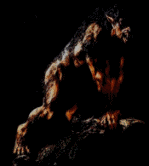 THE
WEREWOLF
THE
WEREWOLF
|
A werewolf (also lycanthrope) is a person who shapeshifts into a wolf or wolflike creature, either purposely, by using magic, or after being placed under a curse. They are said to be immortal.The medieval chronicler Gervase of Tibury associated the transformation with the appearance of the full moon, but this concept was rarely associated with the werewolf until the idea was picked up by fiction writers. In popular culture, a werewolf can be killed if shot by a silver bullet, although this was not a feature of the folk legends. The name most likely derives from Old English wer (or were) and wulf. The first part, wer, translates as "man" (in the sense of male human, not the race of humanity). It has cognates in several Germanic languages including Gothic wair, Old High German wer and Old Norse var, as well as in other Indo-European languages, such as Latin vir, Irish fear, Lthuanian vyras and Welsh gwr, which have the same meaning. The second half, wulf, is the ancestor of modern English"wolf"; in some cases it also had the general meaning "beast". Yet other sources derive the word from warg-wolf, where warg (or later werg and wero) is cognate with Old Norse vargr, meaning "rogue," "outlaw" or, euphemistically, "wolf". A Vargulf was the kind of wolf that slaughtered many members of a flock or herd, but ate only a little of the kill. This was a serious problem for herders, who had to somehow destroy the individual wolf that had run mad before it destroyed their entire flock or herd. They would then often hang the wolf's hide in the bedroom of a young infant, believing it to give the baby supernatural powers. Warg by itself was used in Old English for this specific kind of wolf (see Tolkein's book The Hobbit) and for what would now be called a serial killer. Possibly related is the fact that, in Norse society, outlaws (who could be killed at will with no legal repercussions and were forbidden to receive aid) were often referred to as vargr; that is, wolf. The Greek term lycanthropy (a compound of which the first part derives from the same Proto-Indo-European root for "wolf", *wlkwo-, as the English word) is also commonly used for the "wolf - man" transformation. The term for the metamorphosis of people into animals in general, rather than wolves specifically, is therianthropy (therianthrope means beast-man). In Greek mythology the story of Lycaon supplies one of the earliest examples of a werewolf legend. According to one form of it Lycaon was transformed into a wolf as a result of eating human flesh; one of those who were present at periodical sacrifice on Mount Lycaon was said to suffer a similar fate. The Roman Pliny the Elder, quoting Euanthes, says that a man of Anthus' family was selected by lot and brought to a lake in Arcadia, where he hung his clothing on an ash tree and swam across. This resulted in his being transformed into a wolf, and he wandered in this shape for nine years. Then, if he had attacked no human being, he was at liberty to swim back and resume his former shape. Probably the two stories are identical, though we hear nothing of participation in the Lycaean sacrifice by the descendant of Antaeus. |
![]() Copyright(C) 2007
- 2020. All rights reserved.
Copyright(C) 2007
- 2020. All rights reserved.
